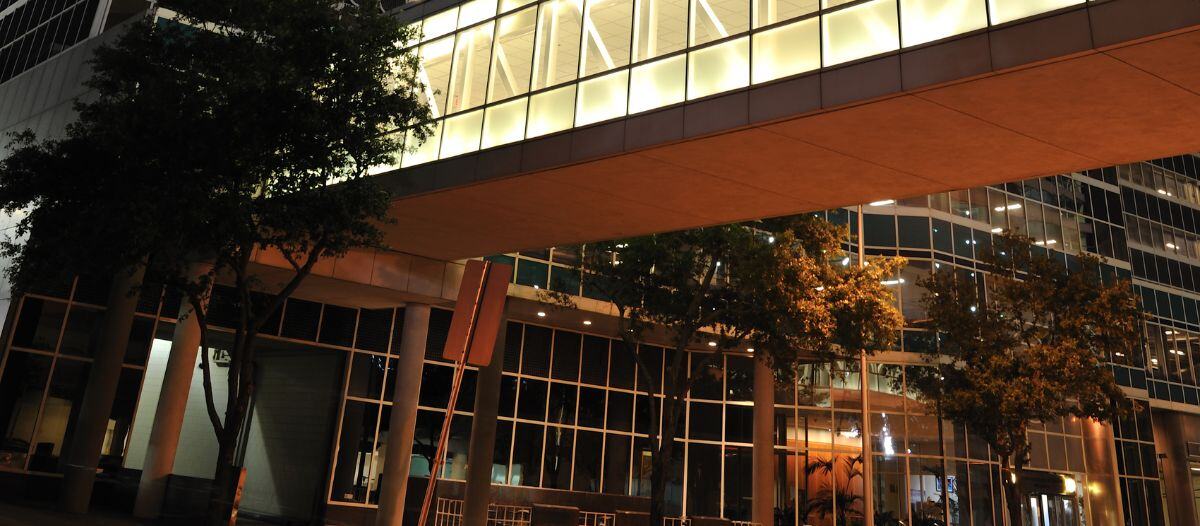A Good Neighbor
Design strategies for urban medical campuses

1. Mitigate environmental impacts through better energy efficiency & utility management planning
Because of their large land area footprint and the high demand and intensive energy use inherent in their essential operations, medical institutions generate significant environmental impacts. The health care sector’s climate impact is equivalent to 4.4 percent of global net carbon emissions, according to the international nongovernmental organization Health Care Without Harm. This is especially significant as the World Health Organization identifies clean air and safe drinking water as essential social and environmental determinants of health that are placed at risk by climate change.
It is therefore crucial for any large-scale facilities master planning initiative or capital project to account for these realities. What does this look like in concrete terms? It means that FM and design teams must push medical institutions to utilize forward-looking building systems and utility management practices. When possible, on-site renewable power generation and storage infrastructure should be explored as an alternative to traditional sources. Advances in photovoltaic panel technology, for instance, have led to efficiency increases that make this approach more suitable for urban hospitals with minimal roof area – at the very least, as a supplement to other power sources. As more governments push for building electrification to reduce local fossil fuel use, health care FM leaders should explore possibilities for both grid integration and independent microgrid solutions.
At the level of individual buildings, climate impacts can also be mitigated with the use of highly efficient fixtures and appliances. LED lighting, low-flow plumbing fixtures and efficient appliances (e.g., in-house laundry), are straightforward upgrades. It is also worth recognizing that the latest generations of even the most energy-intensive medical equipment – MRI machines, for instance – are designed for significant energy savings. The replacement and upgrading of such equipment should be considered a priority in capital projects; the upfront cost will be more than made up over time by energy savings and positive impact on institutional carbon footprints.
A forward-looking approach to mechanical, electrical and plumbing (MEP) systems can further minimize local emissions and reduce energy and resource use. For example, improvements in standards for greywater reuse systems -- which treat used water with chlorine and ultraviolet light, then recycle it for flushing toilets and the like – make them safer and more effective in health care settings.
In addition to reduced carbon emissions, efficient and sustainable building systems contribute to important public health outcomes such as improved air quality, decreases in particulate matter and reduced noise pollution. Other benefits include a better experience in surrounding open and public spaces for patients and community members. This is doubly valuable in city neighborhoods with historically higher rates of chronic respiratory illness and related health concerns as a direct impact of poor air quality.
2. Address public health & accessibility challenges with urban design & mobility improvements
A medical institution must be physically accessible to effectively serve its community and user groups. In urban settings, however, insufficient infrastructure and challenged public transit often create issues of access – especially for low-income patients, visitors and staff without private cars. These difficulties are compounded by high volumes of vehicular traffic, which create unsafe pedestrian environments that are lacking in clear wayfinding and circulation patterns for drop-off, parking and pick-up.
For FM leaders and design teams, planning and urban design strategies have a clear role in solving these accessibility challenges and promoting public health. As a first step, any planning or building initiative should consider ways to develop and expand safe and accessible routes from campus facilities to public transit options. Patient programming spaces and all primary entries should be located within a 10-minute walk of a transit hub or transit stop. Effective infrastructure upgrades include increasing the amount of available bike storage, widening sidewalks, installing additional mid-block pedestrian crossings and implementing smart signal systems. At the building level, new and renovated facilities should include, where possible, permeable and inviting ground-floor and street-front facades. This creates an active connection between the campus and the public right-of-way, emphasizing the campus’ physical and psychological accessibility.
By creating these kinds of walkable environments around and within the medical campus, FM professionals can simplify access for all levels of in- and outpatient care, improve public health outcomes and reduce carbon emissions.
A more walkable campus creates natural incentives for transit use and reduces emissions from private vehicles, lowering the overall carbon footprint of activity associated with the institution. In addition, the employment of active design principles, such as using color and wayfinding cues to promote physical movement, can also foster healthy behaviors for patients and the broader community. This has long been a focus for hospitals at their inpatient and rehabilitative facilities, and in other health care settings in which patient engagement and activity is important.
3. Plan for severe weather through resilient infrastructure design & stormwater management
Every year brings more – and more severe – weather events, and the risks of flooding and stormwater are top of mind for FM professionals. Given the scale of many health care campuses, and the essential nature of their operations, a major flood event holds the potential for catastrophic impacts. But that same campus scale also presents a valuable opportunity for protecting institutions and even surrounding neighborhoods from climate-related water events.
An overall resiliency strategy will be shaped by factors including local climate, hydrogeology, existing building and site characteristics, as well as municipal policy and mandated utility management practices. As with any significant upgrades to institutional infrastructure, it is important for FM leaders to coordinate closely with municipal leaders – who may be able to use city resources to support the hospital’s utility master plan. In cities such as Philadelphia, Pennsylvania, USA, for example, municipal public works departments offer grant funding and ongoing utility cost credits to hospitals and other institutions that build and install green infrastructure on their properties.
What might that green infrastructure look like in practice? In general, the first and most effective upgrades improve on-site water retention and detention through the creation of robust and resilient stormwater systems. The recent research campus for the Children’s Hospital of Philadelphia (CHOP) offers a useful case study. Here, the design team proactively developed a solution for the public realm that addresses both current and future stormwater risks. Throughout the 8.55-acre riverfront campus, a combination of green roofs, rain gardens and underground cisterns are expressed as landscape design features that improve the public realm and enable the collection, conveyance and retention of 85 percent of the stormwater that hits the site.
Custom-designed wood benches provide extensive public seating while also holding planters that help to manage and direct water flow through the site, as well as extensive greenery and tree cover that improves shading and air quality. A similarly planted grand processional stair uses terraces to give form to the sloped campus, also creating an opportunity for ramps that improve wheelchair access.
As these examples demonstrate, there are clear benefits to facility planning and design initiatives that take a holistic approach to the medical campus. In the face of interrelated climate and public health crises, this approach is more crucial than ever. When designers and FM professionals recognize that smart planning can reduce carbon emissions, enhance public access, foster more active lifestyles and improve community health, manage stormwater and protect entire neighborhoods against flood events simultaneously the opportunities to effect positive change will feel irresistible.

Anjulie Palta is an associate with Cooper Robertson, an architecture and urban design firm based in New York, New York, USA. In her role with the firm, she serves as a leader on large-scale institutional master planning efforts, including for major hospital systems.
Read more on Project Management , Communication and Real Estate
Explore All FMJ Topics









